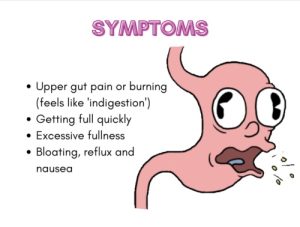 Persistent or recurrent pain or discomfort in epigastric area which is associated with fullness, early satiety, bloating, nausea and belching.
Persistent or recurrent pain or discomfort in epigastric area which is associated with fullness, early satiety, bloating, nausea and belching.
Dyspepsia is defined as pain or discomfort in the abdomen and is a presenting symptom of approximately 81% of people with peptic ulcer disease.
Up to 40% of adults experience symptoms at least once a year.
About 80% of patients with dyspepsia have normal findings on esophagogastroduodenoscopy.
It is a nonspecific symptom that may be caused by peptic ulcer disease and reflux disease, or functional dyspepsia, which is defined as dyspepsia without abnormalities at endoscopy.
Most patients have functional dyspepsia with no findings, but other causes include peptic ulcer disease (15-25%), Helicobacter pylori infection (30-60%), gastrointestinal reflux disease gastric cancer and secondary to use of drugs such associated nonsteroidal anti-inflammatory drugs.
Empiric acid suppressive therapy without diagnostic examination is reasonable in patients less than 45 years of age.
Work-up may include upper gastrointestinal endoscopy, esophageal pH monitoring, gastric emptying times studies and water load tests.
